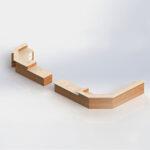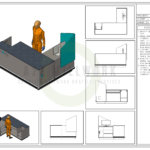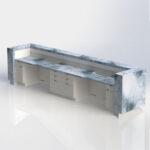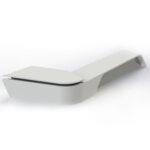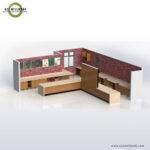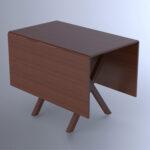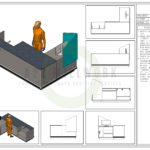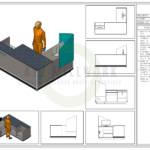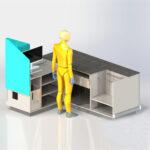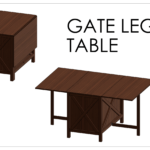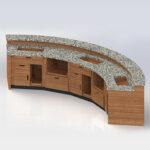Building Information Modeling (BIM) has revolutionized the construction and design industry through the way projects are conceptualized, planned, and executed. One essential aspect of BIM is the Level of Development (LOD), which plays a critical role in ensuring the accuracy and efficiency of various project components, including millwork shop drawings. In this comprehensive guide, we delve into the significance of BIM Level of Development : A Comprehensive Guide and its application in the realm of shop drawings.
Understanding BIM Level of Development
Understanding the concept of Building Information Modeling (BIM) Level of Development (LOD) is crucial. LOD serves as a standardized framework that defines the extent of detail and accuracy within a BIM model at different project stages.For Solidworks drawings LOD plays a pivotal role in ensuring precision and efficiency.

In the world of millwork, LOD denotes the level of detail in the BIM model that directly corresponds to the level of detail required for producing accurate shop drawings. At LOD 100, basic shapes and sizes of millwork components are represented, providing a preliminary understanding of their spatial relationships. As the LOD increases, so does the intricacy of the information.
For millwork shop drawings, achieving a higher LOD—such as LOD 300 or above—ensures that every element is meticulously defined. This includes dimensions, materials, connections, and finishes. The result is shop drawings that not only offer clear instructions for fabrication and installation but also minimize the potential for errors, rework, and misinterpretations.
In essence, BIM Level of Development brings a structured approach to millwork drawings, aligning the depth of information with the project’s stage. It enables effective collaboration among designers, manufacturers, and contractors, leading to the creation of accurate and high-quality millwork elements that seamlessly integrate into the larger construction process.
BIM and Millwork Shop Drawings

BIM, or Building Information Modeling, revolutionizes millwork shop drawings by providing a comprehensive digital representation of design and construction. BIM integrates architectural details, measurements, materials, and spatial relationships, enhancing the accuracy and efficiency of shop drawings. This technology streamlines communication among designers, manufacturers, and contractors, resulting in precise and well-coordinated fabrication and installation of millwork elements. BIM-driven drawings save time and resources to ensure a seamless integration of these elements into the larger construction process.
Applying LOD to Millwork Shop Drawings
(Level of Development) LOD 100
LOD 100 represents the initial stage in Building Information Modeling (BIM). At this level, basic geometric shapes and sizes are depicted, offering a foundational understanding of spatial relationships within a design. While lacking detailed specifics, LOD 100 serves as a starting point for project visualization and collaboration among stakeholders. As the first step in the LOD framework, it lays the groundwork for the development of more intricate and accurate representations in subsequent levels.
LOD 200
Level of Development 200, is a BIM (Building Information Modeling) term that signifies a moderate level of detail in a digital construction model. At LOD 200, the model contains basic geometrical shapes and represents the approximate size, shape, and location of building components. It provides a visual representation for initial conceptualization and planning purposes. While not suitable for construction documentation, LOD 200 aids collaboration and decision-making early in the design phase, allowing stakeholders to grasp the project’s scope and direction. As the BIM process advances, models progress to higher levels of detail, accuracy, and information integration.
LOD 300
LOD 300 represents a comprehensive level of detail. At this point, elements within the model are fully defined, encompassing precise measurements, materials, connections, and finishes. LOD 300 is essential for translating design intent into practicality, ensuring accurate fabrication and construction. It enables effective coordination among project stakeholders, reduces errors, and streamlines the execution phase. This level of development forms a bridge between conceptual design and practical implementation, providing the foundation for successful construction and project delivery.
LOD 400
LOD 400, or Level of Development 400, is a precise standard represents a highly detailed and accurate model that includes information beyond geometry, such as fabrication, assembly, and construction details. LOD 400 models are typically used in the construction phase, offering a comprehensive view of how building components come together. These models aid in coordination, clash detection, and accurate quantity take-offs. With LOD 400, project stakeholders gain a deeper insight into the building process, facilitating efficient construction management and reducing conflicts on-site. It’s a critical tool for seamless project execution in the architecture, engineering, and construction industries.
LOD 500
LOD 500 marks the apex of BIM detail. It extends beyond construction, focusing on post-construction aspects. This level captures operation and maintenance data, facilitating facility management. LOD 500 delivers a comprehensive set of information for long-term sustainability, encompassing details like equipment specifications, maintenance schedules, and replacement guidelines. It ensures that building owners and facility managers possess essential data to optimize building performance, future renovations, and ongoing maintenance. LOD 500 exemplifies BIM’s enduring value by supporting a building’s entire lifecycle, from design and construction to operation and beyond.
Sum Up
In the world of construction and design, BIM Level of Development serves as a guiding framework for accuracy, collaboration, and efficiency. Particularly when it comes to millwork shop drawings, applying BIM LOD ensures that every detail, from design to fabrication and installation, is meticulously documented and communicated. LOD streamlines the construction process and results in higher-quality outcomes. By embracing BIM and its LOD levels, the construction industry takes a significant stride towards achieving precision, cost-effectiveness, and innovation in millwork design and execution.


